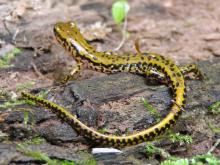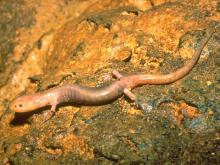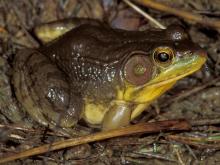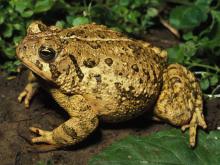Reptiles and Amphibians
Media

Species Types
Scientific Name
Notophthalmus viridescens louisianensis
Description
A small, olive-brown salamander with a fascinating life cycle, the central newt lives in and around woodland ponds and swamps in all but our far northwestern counties.
Media

Species Types
Scientific Name
Hemidactylium scutatum
Description
A glacial relict in Missouri’s eastern Ozarks, the four-toed salamander lives among mosses in heavily forested streams and creeks and sinkhole ponds. It has a thick, round tail that is constricted at its base. There are four toes on each limb.
Media

Species Types
Scientific Name
Eurycea longicauda longicauda (eastern dark-sided salamander) and E. l. melanopleura (dark-sided salamander)
Description
The eastern long-tailed salamander and closely related dark-sided salamander are agile and can escape predators by using their tails for quick jumps. They live in the southern and eastern parts of Missouri.
Media

Species Types
Scientific Name
Eurycea spelaea
Description
The grotto salamander is Missouri’s only species of blind salamander. A true troglobite, it lives in total darkness and has small eyes that are completely or partially covered by their pink or beige skin. Occurs in wet caves in the Ozarks.
Media

Species Types
Scientific Name
Lithobates clamitans (formerly Rana clamitans)
Description
The green frog looks similar to a bullfrog but is smaller and has a ridge of skin along the sides of the back that is not found on bullfrogs. It is a game animal in Missouri.
Media

Species Types
Scientific Name
Anaxyrus americanus (formerly Bufo americanus)
Description
American toads are well-known and occur statewide. Missouri has two subspecies: the eastern American toad in the northern half, and the dwarf American toad in the southern half.
Media

Species Types
Scientific Name
Pseudacris crucifer
Description
The voices of spring peepers are a true announcement that winter is ending. These small, slender frogs can be several overall colors, but seeing an X on the back is a good way to ensure your identification.
Media

Species Types
Scientific Name
Anaxyrus fowleri
Description
Fowler's toad is the common toad of gravel and sand bars along our many Ozark streams and rivers. It is also the most common toad in the Bootheel lowlands.
Media

Species Types
Scientific Name
Anaxyrus woodhousii woodhousii
Description
The Rocky Mountain toad has a number of irregular dark brown or black spots on the back and a white belly. It occurs in the Missouri River floodplain, mostly from the central to the far northwestern parts of the state.
Media

Species Types
Scientific Name
Acris blanchardi (formerly Acris crepitans blanchardi)
Description
Blanchard's cricket frog is a nonclimbing member of the treefrog family. It lacks the adhesive toe pads associated with treefrogs. It occurs statewide. The call is a metallic “gick, gick, gick.”
See Also
About Reptiles and Amphibians in Missouri
Missouri’s herptiles comprise 43 amphibians and 75 reptiles. Amphibians, including salamanders, toads, and frogs, are vertebrate animals that spend at least part of their life cycle in water. They usually have moist skin, lack scales or claws, and are ectothermal (cold-blooded), so they do not produce their own body heat the way birds and mammals do. Reptiles, including turtles, lizards, and snakes, are also vertebrates, and most are ectothermal, but unlike amphibians, reptiles have dry skin with scales, the ones with legs have claws, and they do not have to live part of their lives in water.





















